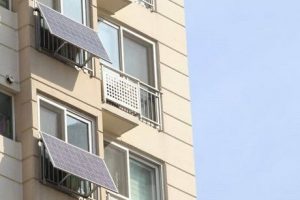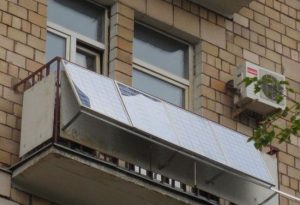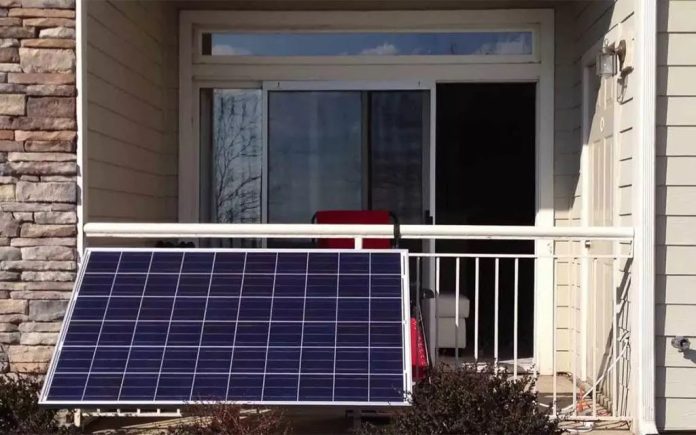In Europe now, quite high utility rates, including electricity. That is why apartments have become increasingly interested in balcony photovoltaic, that is, solar panels installed on the balcony. Since there is no possibility to place solar modules on a roof or a land plot in apartment buildings, the owners of the apartments install them near window openings on the outside of the building or on the balcony. In this way, they manage to generate electricity to meet their own energy needs. This step allows you to save considerably on paying utility bills and reduce the load on the network.
 In order to make this system work for the owner of an apartment, you simply need to buy a special solar panel and connect it to the power grid. In the conversion of housing, there is no need. The solar battery created for installation on the balcony is equipped with a micro-inverter attached to the back of the device.
In order to make this system work for the owner of an apartment, you simply need to buy a special solar panel and connect it to the power grid. In the conversion of housing, there is no need. The solar battery created for installation on the balcony is equipped with a micro-inverter attached to the back of the device.
Solar panels of this type are not included in the field of regulation by European legislation regarding renewable energy sources. If the owner of the apartment acquires such a device, then the “green” tariff for it will not apply, since the equipment of this area with solar panels in the laws is not indicate.
For a long time the balcony panels remained in the so-called “gray zone”. From the point of view of jurisprudence, there were no prohibitions for their installation. The same was true of technical regulation – at some points the panels were simply not notice. At the same time, Germany, in contrast to other countries, drew attention and the regulatory requirements of the Union of Electrical Devices forbade the connection of panels to the network of the house, since this could lead to the emergence of excessive load.
This prohibition was interpret in different ways, therefore, some authoritative institutions allowed the installation of balcony panels, the power of which does not exceed 600 watts. This duality entailed a massive installation of solar modules on the balconies of multi-storey buildings. Organizations that dealt with the sale of electricity occasionally clashed with ordinary citizens, and representatives of the legal sector did not see in this moment the risk to consumers.
The end of 2017 was mark by the development of a new technical standard, called DIN VDE 0100-551-1. This project concerns low-voltage equipment for generating electricity and connecting devices for generating electricity and working together with other energy sources. This standard will greatly simplify the use of balcony solar modules in terms of legislation. It is plan that the project will be implement next year. It should be note that Austria, Portugal and Switzerland have already legalized the installation of balcony solar stations.
The essence of the work of an apartment solar station is that it adds electricity to the network of a separate apartment, thereby reducing power consumption from the common network.
It is worth paying attention to the fact that any installation that produces electricity cannot be safely connect to a power outlet. There are certain requirements that the generating devices must meet. Switzerland has a number of requirements for balcony panels:
– maximum current intensity – 2,6 A;
– MAX voltage – 230 V;
– The power plant should not exceed 600 watts.
In addition, the balcony panels must be equipped with a protective shutdown system.
Among the prohibitions, the counter is also rotate in the other direction. Such a case can occur when photovoltaic electricity generates more electricity than a separate apartment requires. This problem is simply solve – just set the reverse rotation limiter.
 The price of solar modules for balconies in European markets ranges from 1.2 to 1.5 euros per 1W. By simple deductions, it can be determined that a panel that has a power of three hundred watts will cost about 400 euros.
The price of solar modules for balconies in European markets ranges from 1.2 to 1.5 euros per 1W. By simple deductions, it can be determined that a panel that has a power of three hundred watts will cost about 400 euros.
In southern Germany, the balcony station, whose panels are located on the facade of the building, is capable of generating approximately 330 kWh during the year. This amount is about 10 percent of the energy consumption of a small household throughout the year. If the energy needs of the apartment will allow consuming all the generated electricity, and the tariff of the common network will be 29 eurocents per kilowatt-hour, the balcony installation will have a rather short payback period.
The solar station can also be equipped with power storage. Now, this is practical not done, since it requires more financial investments, forces and places in the apartment.
Photovoltaic is a rather unpleasant moment for the energy market. It significantly reduces energy consumption and profit in the system of “energy production-network-realization”.
Balcony solar stations are becoming an increasingly powerful competitor for traditional energy, and right now, it is worth revising the foundations for comfortable coexistence. In the near future, the price of new technologies will decrease and its popularity will grow significantly.


